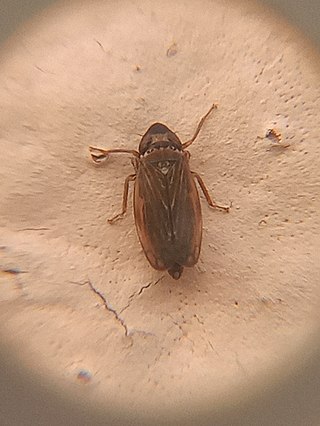
Deltocephalinae is a subfamily of leafhoppers. Deltocephalinae is the largest subfamily in the family Cicadellidae and is divided into 40 tribes, comprising over 925 genera, and over 6,700 described species.

Macrostelini is a tribe in the Deltocephalinae subfamily of leafhoppers. Macrostelini contains 37 genera and over 300 species. The tribe has a cosmopolitan distribution. Some species in the genus Cicadulina are agricultural pests and transmit maize streak virus in Sub-saharan Africa.

Athysanini is a tribe of leafhoppers in the subfamily Deltocephalinae. The type genus of the tribe is Athysanus. The tribe has a cosmopolitan distribution. It is the largest tribe in the subfamily Deltocephalinae and has 228 genera and at least 1120 species.

Deltocephalini is a tribe of leafhoppers in the subfamily Deltocephalinae. Deltocephalini contains 72 genera and more than 600 species.

Scaphoideini is a tribe of leafhoppers. There are 64 genera and over 600 described species in Scaphoideini.
Acinopterini is a tribe of leafhoppers in the subfamily Deltocephalinae. Acinopterini is made up of 2 genera over 35 species. Acinopterus is widely distributed throughout North and South America with more than 30 species; Cariancha and its two species are endemic to Brazil.
Acostemmini is a tribe of leafhoppers in the subfamily Deltocephalinae. Acostemmini contains 12 genera and around 30 species. The tribe is found throughout tropical Africa, the Indian subcontinent and New Guinea. The highest diversity is found in Madagascar including an endemic genus, Ikelibeloha.
Bahitini is a tribe of leafhoppers in the subfamily Deltocephalinae. Bahitini contains 25 genera and over 165 species.
Chiasmini is a tribe of leafhoppers in the subfamily Deltocephalinae. Chiasmini contains 21 genera and over 300 species. Some species of Chiasmini in the genus Nephotettix are agricultural pests and transmit rice Tungrovirus in southeast Asia.
Cicadulini is a tribe of leafhoppers in the subfamily Deltocephalinae. There are 15 genera and over 120 species in Cicadulini.
Cochlorhinini is a tribe of leafhoppers in the subfamily Deltocephalinae. The tribe is endemic to the western United States and adjacent parts of Mexico, however at least one species has been introduced to Chile. Cochlorhinini contains 11 genera and over 140 species.
Eupelicini is a tribe of leafhoppers in the subfamily Deltocephalinae. Eupelicini contains 7 genera and over 60 species divided into two subtribes: Eupelicina and Paradorydiina.
Faltalini is a tribe of leafhoppers in the subfamily Deltocephalinae. Faltalini is distributed from the southwestern United States south to Argentina and Chile. It contains 11 genera and over 25 species.
Goniagnathini is a tribe of leafhoppers in the subfamily Deltocephalinae. Goniagnathini contains 4 genera and around 60 species. Of these, one new species, Goniagnathuscornutus was recently verified in China.
Koebeliini is a tribe of leafhoppers in the subfamily Deltocephalinae. There are 6 genera and over 15 species divided into two subtribes within Koebeliini: Koebellina and Grypotina. Koebeliina species are endemic to western North America.
Magnentiini is a tribe of leafhoppers in the subfamily Deltocephalinae. There are currently 2 genera and 4 species in the tribe. It was formerly placed in the subfamily Nioniinae, but was moved to Deltocephalinae based on anatomical similarities. Members of Magnentiini are superficially similar to members of Punctulini and Vartini.
Occinirvana eborea is a species of leafhopper in the subfamily Deltocephalinae. It is the only member of the genus Occinirvana and the tribe Occinirvanini, making them both monotypic taxa. O. eborea is endemic to Western Australia. It is closely related to Loralia, another genus of leafhoppers endemic to Australia.
Paralimnini is a tribe of leafhoppers in the subfamily Deltocephalinae. Paralimnini contains 139 genera and over 900 species divided into two subtribes: Aglenina and Paralimnina. The tribe has a cosmopolitan distribution.

Stenometopiini is a tribe of leafhoppers in the subfamily Deltocephalinae. It contains 8 genera and around 100 species. The members of Stenometopiini are widespread and have a cosmopolitan distribution.
Vartini is a tribe of leafhoppers in the subfamily Deltocephalinae. It currently contains 7 genera and over 20 species. Phylogenetic studies have shown that Vartini is closely related to Punctulini.






